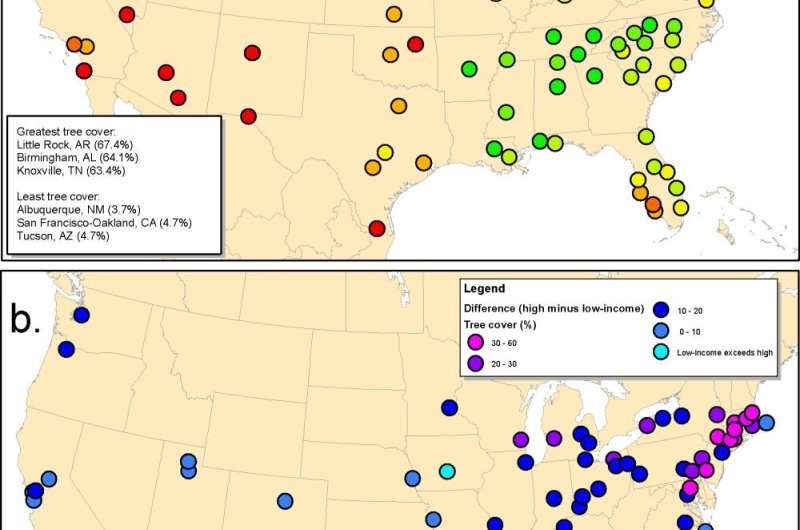Tree cover for United States large urbanized areas.a.) Population-weighted median tree cover. b.) The absolute difference between low-income blocks (lowest quartile of income) and high-income blocks (highest quartile of income) in tree cover Credit: McDonald et al, 2021, PLOS ONE (CC-BY 4.0, creativecommons.org/licenses/by/4.0/)
A new analysis of thousands of U.S. communities finds that, on average, low-income urban blocks have less tree cover and are hotter than high-income blocks. Robert McDonald of The Nature Conservancy in Arlington, Virginia, and colleagues present these findings in the open-access journal PLOS ONE on April 28, 2021.
Mounting research links urban tree cover with human health benefits, including reduced air pollution, better cardiovascular function, and improved mental health. Tree cover can also cool urban areas, mitigating the effects of heat waves. However, research from the U.S. and other countries suggests that urban tree cover is unequally distributed, with low-income and minority communities often having less tree cover.
In the new study, McDonald and colleagues sought to quantify urban tree cover and temperature disparities in the U.S. at the resolution of individual blocks. They used digital images from the National Agriculture Imagery Program to examine tree cover in the 100 largest urban areas of the U.S, covering 5,723 cities, towns, and other Census-designated places that are collectively home to 167 million people. They also used Landsat imagery to analyze summertime temperatures in these communities.
The analysis revealed lower levels of tree cover for low- versus high-income blocks in 92 percent of the communities studied. Tree cover was 15.2 percent less, on average, for low-versus high-income blocks, and low-income blocks were hotter by an average of 1.5°C. The Northeast U.S. showed the greatest disparities, with low-income blocks in some urban areas having 30 percent less tree cover while being 4°C hotter than high-income blocks.
The researchers also found that blocks with a greater proportion of people of color had less tree cover and hotter summer temperatures. This link between race and urban tree canopy held up even after accounting for other factors like population density and income.
In total, low-income blocks have 62 million fewer trees than comparable high-income blocks. The researchers estimate that this disparity could be addressed by a $17.6 billion investment in tree planting and natural regeneration, which could benefit 42 million people.
The authors add: "We had expected low-income and minority neighborhoods to have less tree cover and so be more at risk during summer heat waves, but we were still surprised and troubles at how widespread this tree inequality was, with 92% of communities having lower tree cover in low-income than in high-income areas."
More information: McDonald RI, Biswas T, Sachar C, Housman I, Boucher TM, Balk D, et al. (2021) The tree cover and temperature disparity in US urbanized areas: Quantifying the association with income across 5,723 communities. PLoS ONE 16(4): e0249715. doi.org/10.1371/journal.pone.0249715
Journal information: PLoS ONE
Provided by Public Library of Science
























